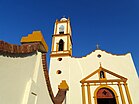Papantla | |
|---|---|
City and municipality | |
| Papantla de Olarte | |
|
Top: Panoramic view of Papantla's Downtown; Middle: Papantla Municipal Hall, Main Plaza; Bottom: El Tajín Archaeological Zone, Our Lady of the Assumption Church | |
| Coordinates: 20°26′52″N 97°19′12″W / 20.44778°N 97.32000°W | |
| Country | |
| State | Veracruz |
| Founded | 13th century |
| Municipal Status | 1880 |
| Government | |
| • Mayor | Yamir de Jesús de la Cruz Patiño (MORENA) |
| Area | |
| • Municipality | 1,458.5 km2 (563.1 sq mi) |
| Elevation (of seat) | 180 m (590 ft) |
| Population (2020) | |
| • Municipality | 159,910 |
| • Density | 109.6/km2 (284/sq mi) |
| • Seat | 55,452 |
| Time zone | UTC-6 (Central (US Central)) |
| • Summer (DST) | UTC-5 (Central) |
| Postal code (of seat) | 93400 |
| Demonym | papanteco |
Papantla (Spanish: [paˈpantla] ) is a city and municipality located in the north of the Mexican state of Veracruz, in the Sierra Papanteca range and on the Gulf of Mexico.[1] The city was founded in the 13th century by the Totonacs and has dominated the Totonacapan region of the state since then. The region is famed for vanilla, which occurs naturally in this region, the Danza de los Voladores and the El Tajín archeological site, which was named a World Heritage Site.[2] Papantla still has strong communities of Totonacs who maintain the culture and language.[3] The city contains a number of large scale murals and sculptures done by native artist Teodoro Cano García, which honor the Totonac culture.[4] The name Papantla is from Nahuatl and most often interpreted to mean "place of the papanes" (a species of crow). This meaning is reflected in the municipality's coat of arms.[1][2]
- ^ a b "Enciclopedia de los Municipios de México Estado de Veracruz Papantla" (in Spanish). Mexico: INAFED. Archived from the original on February 19, 2010. Retrieved February 8, 2010.
- ^ a b "Historia de Papantla" (in Spanish). Mexico: INAFED. 2005. Retrieved February 8, 2010. [dead link]
- ^ "Historia de la Ciudad de Papantla" [History of the City of Papantla] (in Spanish). Monterrey, Mexico: ITESM. Archived from the original on 2021-05-10. Retrieved 2010-02-08.
- ^ Ferral, María Elena (2006-10-23). "Teodoro Cano talento artístico portentoso, de Papantla para el mundo" [Teodoro Cano talented artest from Papantla for the world]. Diario de Xalapa (in Spanish). Xalapa, Mexico. Retrieved 2010-02-08. [dead link]







